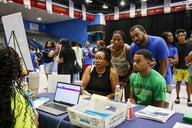You have /5 articles left.
Sign up for a free account or log in.
When our Board of Trustees first heard about our president being sent some threatening communications, we weren’t too worried. The president is well liked, affable and easily recognized in the community. With 60,000 students enrolled, three campuses and a $300 million operating budget, she’s an astute, popular figure whose energy and goodwill are legendary. She has led efforts that have raised $23 million in scholarships for needy students during her tenure.
Her nonstop schedule, however, frequently takes her out late at night, often alone, sometimes a couple hours’ drive from our campus. It is no exaggeration to say that she will travel anywhere to promote our college: she delivered a GED graduation speech at a correctional facility and mentors college students who are also teen parents in the community. She has a reputation for searching out students who are isolated or discouraged, giving them her personal phone number and texting them several times a week to check in on class attendance. Having grown up herself on the south side of Chicago, she has earned what she calls a well-rooted sense of invincibility.
Our president is also African-American and openly gay, and she talks very publicly about closing the achievement gap for students of color. She writes often about making our institution more LGBTQ friendly and nurtures what she calls “radical inclusion.” She led the charge to allow Deferred Action for Childhood Arrivals students -- undocumented immigrants who were brought to the United States as children but are now college age -- to attend our institution at in-state tuition rates.
Any one of those elements could attract hostility from the unbalanced or the narrow-minded, but in a tight economy, and in the wake of a vitriolic presidential election, more folks have seemed to be looking for someone to blame. Some of the rhetoric of the campaigns encouraged those tendencies, making people the targets rather than ideas.
On top of those complexities, our president has made some gutsy -- and unpopular -- business decisions in her quest to expand opportunity to more students. When she determined that several auxiliary programs were running deficits for many years in a row, she took action -- including outsourcing the bookstores on our campuses. Some people lost their jobs, despite the college’s painstaking efforts to move them to new positions. She also closed three child care centers that were losing over a $400,000 a year -- a very unpopular decision. It was unequivocally the right decision for the college, though, given that fewer than 20 of our 60,000 students were using the facilities. We redirected the resources to address student needs, including ones in the Achieving the Promise Academy and our Achieving Collegiate Excellence and Success program, both focused on increasing retention, persistence and graduation rates for at-risk students.
At about that time, we hired a new director of safety and security, a retired police officer with three decades of law-enforcement experience. In the wake of the tragedy at Umpqua Community College in Oregon, we wanted to heighten security for our students and employees, so we sought her out for her expertise. She immediately made changes: stepping up patrols in some high-trafficked areas, implementing active-shooter trainings, putting our security staff in uniforms, taking our local law enforcement teams on walk-throughs of the campuses and installing communications screens in classrooms.
What we didn’t expect, however, was that she would present our president’s safety in a new light: “How would you feel if something happened to your president?” The threats, the controversial business decisions, the late-night travel -- our safety and security director’s decades of experience told her that those were red flags. She demanded to know why we hadn’t acted sooner.
Suddenly we were asking ourselves important questions. Perhaps we needed to change our perspective. With her characteristic nonchalance, the president had brushed off some very explicit threats. She had dismissed our board’s concerns that she might be too unguarded in her interactions with responses like “If my conversations with a student can keep them enrolled or focused or inspired, it’s worth it. If my meeting with a community member can soothe their angst about the child care centers, it’s worth it.”
But the new director was someone who knew about the realities of violence. She had seen stalking and mental illness escalate into violence countless times in her career. Some of the messages to our president had been ugly, racist and homophobic. A man unknown to the college tried to deliver a suspicious package to her office that he claimed had to be given directly to her. A person commenting on social media said she should be “taken out” in reaction to a commencement speech she delivered. It’s not a matter of when someone targets the president, our new director said -- she already is a target.
On the director’s urgent recommendation, we quickly contracted a security firm to provide an officer to accompany the president for a six-month pilot. We did so with the knowledge that we would probably receive pushback, that our judgment would be questioned and that those who were looking to criticize us would do so with impunity. Taxpayer dollars are going to protection for a college president? That’s the headline we will likely face, and we’ve already heard low-level grumblings about it. But to a person, our entire board was willing to take the heat about the decision to protect our president, because she had been willing -- even eager -- to risk much more for our students.
Maybe that’s the story, and the fundamental question, at the end of the day: How far should a president be expected to go for students? Our internal answer has been: a president with the passion and dedication that ours has shown over six years of leadership deserves our wholehearted support. And under these circumstances, that means security.




